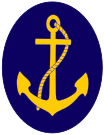Boatswain's mate
Boatswain's mate , just BtsmMaat / BMT ( English Boatswain's mate ) was in the naval forces of some countries a grade , which is currently in the German Navy as the Maat would correspond to (in this case, however, OR-5). The bosun's mate corresponds to the NCO in the Bundeswehr . In the German Navy, mate and chief mate form the rank group of non-commissioned officers .
Germany
(badge of rank)
(raceway badge
liker upper arm)
In addition to the Habsburg Monarchy and the Russian Empire , the German Empire introduced the bosun's mate (in connection with the rank of mate and the general career - sub-unit leader) as the lowest rank of the rank group of portepee NCOs in the Imperial Navy . In the Weimar Republic and the Navy of the Third Reich, the rank was then retained until 1945. The boatswain's mate was comparable to the non-commissioned officer (OR-5) in the army and air force .
Depending on the career or occupation, the hierarchy and title were defined as follows.
- for mates - boatswain's mate , fireworks mate , machinist's mate or helmsman's mate
- for chief mate - chief boatman's mate, chief fireworks mate, chief machinist's mate or chief helmsman's mate
| Rank | ||
| lower: Corporal Corporal |
Mate ( Private , H / Lw) |
higher: Chief Petty Officer |
See also:
Austria-Hungary
Boatswain's mate was the rank of the joint Imperial and Royal Navy of Austria-Hungary (1786 to 1918), which was comparable to the corporal in the joint Austro-Hungarian Army. The ranking was.
- Helmsman
- Boatswain's mate
Russian Empire
Based on the naming in German-speaking naval forces, there was the boatswain's mate in the Imperial Russian Navy (original name in Russian Боцманмат Bozmanmat ), who was comparable to the sergeant (ru: “Старший унтерофицер”.). The ranking was:
- Quartermaster
- Boatswain's mate
- Boatswain
- Guardian
see also: Ranks of the Russian armed forces until 1917
Individual evidence
- ↑ Langenscheidt: The Great Muret Sander . 9th edition. 2002, Volume 1 ... p. 306 / Volume 2 ... p. 1041
- ↑ The abbreviation "OR" stands for "Other Rank, officers excepted / fr: sous-officiers et militaires du rang / ru: другие ранги, кроме офицероф"
- ↑ Brockhaus . The encyclopedia in 24 volumes (1796–2001). Volume 13: ISBN 3-7653-3673-4 , p. 699



